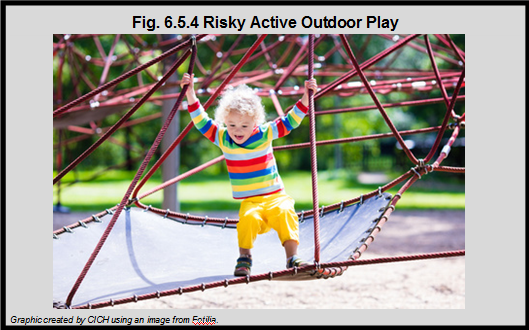Risky Active Outdoor Play

Over the last few decades, there has been an increased focus on childhood injury prevention – in Canada and internationally. The result has been that many childhood injury prevention programs have limited risky play to prevent physical injury. There has been an increasing focus on parents’ supervision – often resulting in less independence for children to play freely and actively. There has also been increasing focus on child abduction.1,2,3,4
A recent systematic review found that the positive health benefits of risky outdoor play outweighed those benefits from limiting outdoor risky play to protect children 3 to 12 years.1
Many studies concluded that promoting risky outdoor play was an opportunity to promote children’s health, development and active lifestyles – and that policies and programs should support such play.1
1Brussoni M, Gibbons R, Gray C, Ishikawa T, Beate E, Sandseter H, Bienenstock A, Chabot G, Fuselli P, Herrington S, Janssen I, Pickett W, Power M, Stanger N, Sampson M and Tremblay MS. What is the Relationship between Risky Outdoor Play and Health in Children? A Systematic Review. Int. J. Environ. Res. Public Health 2015, 12, 6423-6454. https://www.ncbi.nlm.nih.gov/pubmed/26062038-accessed July 24, 2017.
2Jago, R.; Thompson, J.L.; Page, A.S.; Brockman, R.; Cartwright, K.; Fox, K.R. Licence to be active: Parental concerns and 10-11-year-old children’s ability to be independently physically active. J. Public Health. 2009, 31, 472–477. In Brussoni M, Gibbons R, Gray C, Ishikawa T, Beate E, Sandseter H, Bienenstock A, Chabot G, Fuselli P, Herrington S, Janssen I, Pickett W, Power M, Stanger N, Sampson M and Tremblay MS. What is the Relationship between Risky Outdoor Play and Health in Children? A Systematic Review. Int. J. Environ. Res. Public Health 2015, 12, 6423-6454. https://www.ncbi.nlm.nih.gov/pubmed/26062038– accessed July 24, 2017.
3Kalish, M.; Banco, L.; Burke, G.; Lapidus, G. Outdoor play: A survey of parent’s perceptions of their child’s safety. J. Trauma 2010, 69, S218–S222. In Brussoni M, Gibbons R, Gray C, Ishikawa T, Beate E, Sandseter H, Bienenstock A, Chabot G, Fuselli P, Herrington S, Janssen I, Pickett W, Power M, Stanger N, Sampson M and Tremblay MS. What is the Relationship between Risky Outdoor Play and Health in Children? A Systematic Review. Int. J. Environ. Res. Public Health 2015, 12, 6423-6454. https://www.ncbi.nlm.nih.gov/pubmed/26062038-accessed July 24, 2017..
4Alparone, F.R.; Pacilli, M.G. On children’s independent mobility: the interplay of demographic, environmental, and psychosocial factors. Child. Geogr. 2012, 10, 109–122. In Brussoni M, Gibbons R, Gray C, Ishikawa T, Beate E, Sandseter H, Bienenstock A, Chabot G, Fuselli P, Herrington S, Janssen I, Pickett W, Power M, Stanger N, Sampson M and Tremblay MS. What is the Relationship between Risky Outdoor Play and Health in Children? A Systematic Review. Int. J. Environ. Res. Public Health 2015, 12, 6423-6454. https://www.ncbi.nlm.nih.gov/pubmed/26062038-accessed July 24, 2017.
5Position Statement on Active Outdoor Play. Herrington S and Pickett W and: the BC Injury Research and Prevention Unit, CHEO Research Institute, Physical Activity Epidemiology Lab, Best Start, KidActive, Play by Nature, Child and Nature Alliance, Centre de Recherche Institut Universitaire de Cardiologe et de Pneumologe de Québec, Queen Maud University College of Early Childhood Education, Canadian Parks Council, ParticipAction, Evergreen and PHE Canada. http://www.haloresearch.ca/outdoorplay/-accessed July 24, 2017.
What is risky outdoor active play?
It is not play that puts children at extreme risk “like skating on a half-frozen lake or sending a preschooler to the park alone”.
It is play that is “thrilling and exciting”; where children are given freedom to “decide how high to climb, to explore the woods, get dirty, play hide’n seek, wander in their neighbourhoods, balance, tumble and rough-house, especially outdoors, so they can be active, build confidence, autonomy and resilience, develop skills, solve problems and learn their own limits.”5 There is risk of physical injury, but children can recognize and evaluate challenges according to their own ability.5
